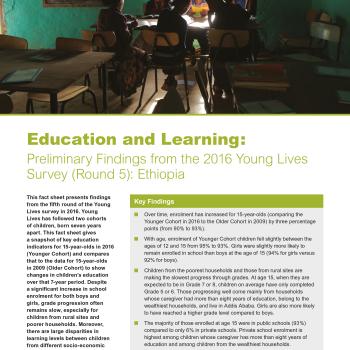
Round 5 Longitudinal Education and Learning Fact Sheet
This fact sheet presents findings from the fifth round of the Young Lives survey in 2016. Young Lives has followed two cohorts of children, born seven years apart. This fact sheet gives a snapshot of key education indicators for 15-year-olds in 2016 (Younger Cohort) and compares that to the data for 15-year-olds in 2009 (Older Cohort) to show changes in children’s education over that 7-year period. Despite a significant increase in school enrolment for both boys and girls, grade progression often remains slow, especially for children from rural sites and poorer households. Moreover, there are large disparities in learning levels between children from different socio-economic groups, as measured by maths and vocabulary tests.
Key Findings:
Over time, enrolment has increased for 15-year-olds (comparing the Younger Cohort in 2016 to the Older Cohort in 2009) by three percentage points (from 90% to 93%). With age, enrolment of Younger Cohort children fell slightly between the ages of 12 and 15 from 95% to 93%. Girls were slightly more likely to remain enrolled in school than boys at the age of 15 (94% for girls versus 92% for boys). Children from the poorest households and those from rural sites are making the slowest progress through grades. At age 15, when they are expected to be in Grade 7 or 8, children on average have only completed Grade 5 or 6. Those progressing well come mainly from households whose caregiver had more than eight years of education, belong to the wealthiest households, and live in Addis Ababa. Girls are also more likely to have reached a higher grade level compared to boys. The majority of those enrolled at age 15 were in public schools (93%) compared to only 6% in private schools. Private school enrolment is highest among children whose caregiver has more than eight years of education and among children from the wealthiest households. The rapid increase in enrolment has not been matched by improvements in learning levels which fall short of national targets. Children from betteroff households, with caregivers who have completed primary school, and those living in urban sites, perform better in tests of maths and vocabulary.

Round 5 Longitudinal Education and Learning Fact Sheet
This fact sheet presents findings from the fifth round of the Young Lives survey in 2016. Young Lives has followed two cohorts of children, born seven years apart. This fact sheet gives a snapshot of key education indicators for 15-year-olds in 2016 (Younger Cohort) and compares that to the data for 15-year-olds in 2009 (Older Cohort) to show changes in children’s education over that 7-year period. Despite a significant increase in school enrolment for both boys and girls, grade progression often remains slow, especially for children from rural sites and poorer households. Moreover, there are large disparities in learning levels between children from different socio-economic groups, as measured by maths and vocabulary tests.
Key Findings:
Over time, enrolment has increased for 15-year-olds (comparing the Younger Cohort in 2016 to the Older Cohort in 2009) by three percentage points (from 90% to 93%). With age, enrolment of Younger Cohort children fell slightly between the ages of 12 and 15 from 95% to 93%. Girls were slightly more likely to remain enrolled in school than boys at the age of 15 (94% for girls versus 92% for boys). Children from the poorest households and those from rural sites are making the slowest progress through grades. At age 15, when they are expected to be in Grade 7 or 8, children on average have only completed Grade 5 or 6. Those progressing well come mainly from households whose caregiver had more than eight years of education, belong to the wealthiest households, and live in Addis Ababa. Girls are also more likely to have reached a higher grade level compared to boys. The majority of those enrolled at age 15 were in public schools (93%) compared to only 6% in private schools. Private school enrolment is highest among children whose caregiver has more than eight years of education and among children from the wealthiest households. The rapid increase in enrolment has not been matched by improvements in learning levels which fall short of national targets. Children from betteroff households, with caregivers who have completed primary school, and those living in urban sites, perform better in tests of maths and vocabulary.

